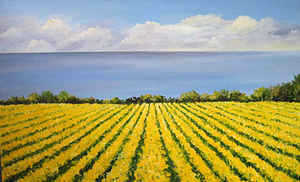
I Wandered Lonely As a Cloud
William Wordsworth
I wandered lonely as a cloud
That floats on high o’er vales and hills,
When all at once I saw a crowd,
A host, of golden daffodils;
Beside the lake, beneath the trees,
Fluttering and dancing in the breeze.
Continuous as the stars that shine
And twinkle on the milky way,
They stretched in never-ending line
Along the margin of a bay:
Ten thousand saw I at a glance,
Tossing their heads in sprightly dance.
The waves beside them danced; but they
Out-did the sparkling waves in glee:
A poet could not but be gay,
In such a jocund company:
I gazed—and gazed—but little thought
What wealth the show to me had brought:
For oft, when on my couch I lie
In vacant or in pensive mood,
They flash upon that inward eye
Which is the bliss of solitude;
And then my heart with pleasure fills,
And dances with the daffodils.
Poem Summary
Stanza 1
In ‘‘I Wandered Lonely as a Cloud’’ the speaker describes what he saw one spring day when he was walking in the English countryside. The first two lines state that he was alone as he walked, and he compares himself to a solitary cloud high in the sky. Then suddenly he comes upon a splendid sight: a multitude of daffodils. The daffodils are under the trees and next to the lake. The daffodils sway from side to side, appearing to dance in the breeze.
Stanza 2
In this stanza the poet continues to describe the daffodils. There are so many of them that he compares them to the stars in the Milky Way. The Milky Way galaxy contains billions of stars and forms a band of light when seen at night from Earth. As the poet looks at them, the daffodils continue in an unbroken line at the edge of the bay. He estimates that there must be 10,000 of them, and they are all dancing in the breeze.
Stanza 3
In Stanza 3 the poet continues to describe the daffodils. He notes that the breeze is also making the water on the lake move in waves, but the daffodils seem even more joyful than the waves as they dance. In line 3, the poet says that it was impossible for a poet not to be happy when in the presence of such lively and cheerful company as the daffodils. In line 5, he tells how he stood for a long time gazing at the daffodils. But at the time, he adds, he did not fully realize how much the sight had enriched him. That realization would only come later, as the final stanza explains.
Stanza 4
In this stanza the poet reflects on his experience of suddenly coming upon all those daffodils. Some time has passed since he took that walk. Often since then, when he is alone, lying on his couch in a thoughtful mood, or with nothing much going on in his mind, he suddenly sees the daffodils once more in his mind’s eye. The memory of the daffodils, and his ability to recreate the vision of them in his mind, brings him great pleasure, and he feels that his own heart is dancing along with the daffodils.
source: Poetry for Students; vol.33; GALE Cengage Learning; Michigan; 2010
